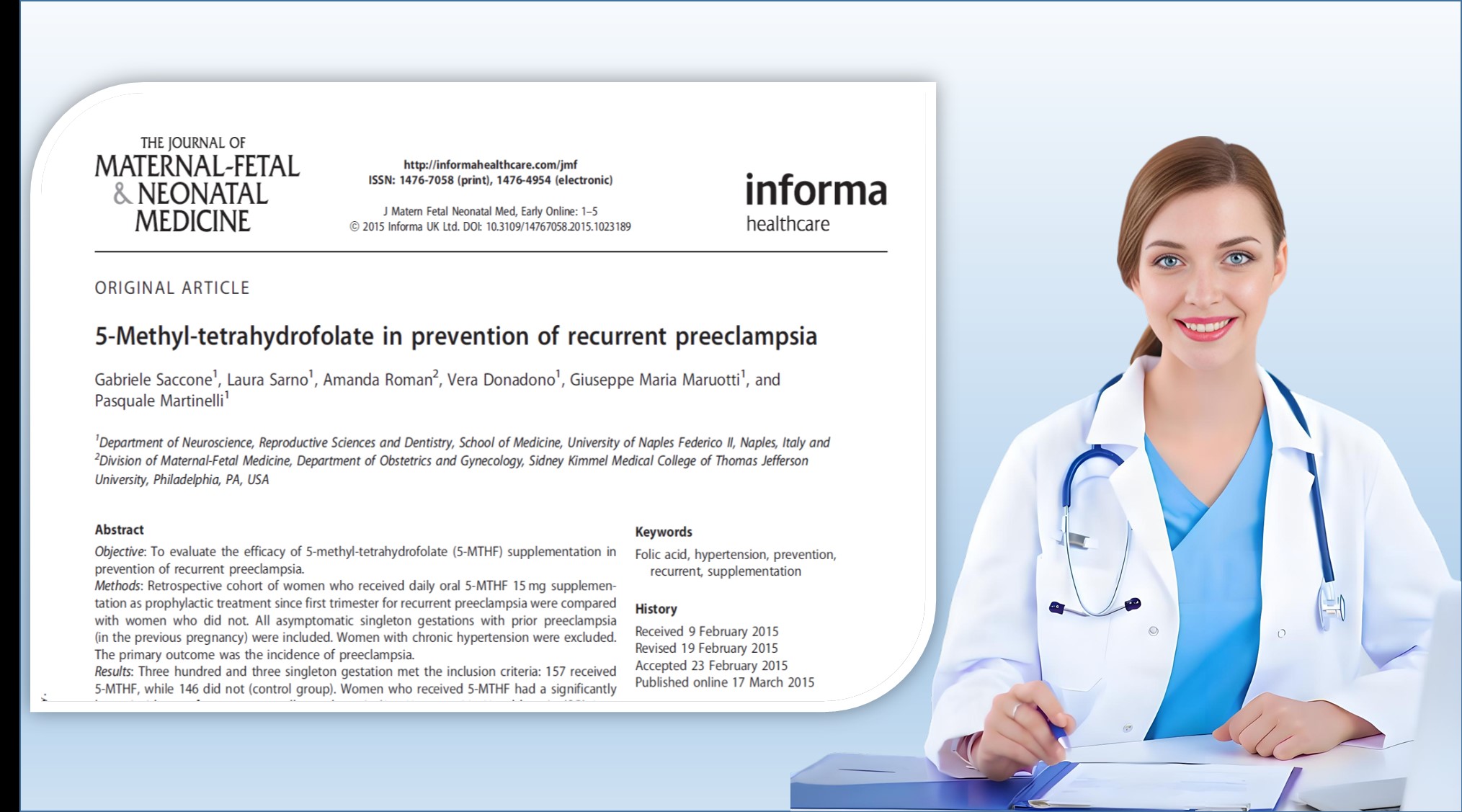A Lifesaver for Second-Time Moms: This Study Reduces the Risk of Preeclampsia by 74.6%
As a second-time mom, Sarah’s experience might resonate with many women who have a history of preeclampsia. During her first pregnancy, she suddenly developed high blood pressure and proteinuria at 32 weeks and was diagnosed with preeclampsia. She had to deliver her baby via emergency cesarean section, and the baby weighed only 1,800 grams and stayed in the neonatal intensive care unit (NICU) for 21 days. Before this pregnancy, Sarah was most worried about the recurrence of preeclampsia.
Following her doctor’s advice, she started taking 15 mg of 5-methyltetrahydrofolate (5-MTHF) every day from the 6th week of pregnancy, along with a low dose of aspirin. Throughout her pregnancy, she regularly monitored her blood pressure and urine protein levels. She eventually had a natural delivery at 38 weeks, and her baby weighed 3,050 grams with an Apgar score of 10. “The second pregnancy was much more reassuring than the first. The doctor said that active folate played a significant role,” she said.
Sarah’s case is not unique. A study published in the Journal of Maternal-Fetal and Neonatal Medicine confirmed that 5-methyltetrahydrofolate can significantly reduce the risk of recurrent preeclampsia.

Medical Research: How Does 5-MTHF Protect Maternal and Infant Health?
(1) Study Design and Data Support
This retrospective study from the University of Naples in Italy included 303 women with a history of singleton pregnancy and previous preeclampsia. Of these, 157 began taking 15 mg of 5-MTHF daily from early pregnancy, while 146 in the control group did not (due to economic reasons). All participants took low-dose aspirin, and factors such as chronic hypertension and MTHFR mutations were excluded.

(2) Key Findings of the Study
In the prevention of preeclampsia and related indicators, the 6S-5-methyltetrahydrofolate group showed significant improvements compared to the control group:
· Overall Recurrence Rate of Preeclampsia: The recurrence rate in the 6S-5-methyltetrahydrofolate group was 21.7%, compared to 39.7% in the control group, a risk reduction of 43% (OR 0.57, 95% CI 0.25-0.69).
· Severe Preeclampsia: The incidence in the 5-MTHF group was 3.2%, compared to 8.9% in the control group, a risk reduction of 56% (OR 0.44, 95% CI 0.12-0.97).
· Early-Onset Preeclampsia (<34 weeks): The incidence in the 6S-5-methyltetrahydrofolate group was 1.9%, compared to 7.5% in the control group, a risk reduction of 66% (OR 0.34, 95% CI 0.07-0.87).
· Neonatal Respiratory Distress Syndrome (RDS): The incidence in the 5-MTHF group was 6.4%, compared to 15.7% in the control group, a risk reduction of 59% (OR 0.38, 95% CI 0.14-0.57).
In terms of neonatal indicators:
· Mean Gestational Age at Delivery: The 6S-5-methyltetrahydrofolate group had a mean gestational age of 37 weeks (259 days), compared to 35.6 weeks (249 days) in the control group. This represents an extension of 10 days in the 6S-5-methyltetrahydrofolate group, approaching the normal range of 37-42 weeks for natural delivery.
· Mean Birth Weight of Newborns: The mean birth weight in the 6S-5-methyltetrahydrofolate group was 2,983 grams, compared to 2,518 grams in the control group. This represents an increase of 465 grams in the 5-MTHF group.
The 6S-5-methyltetrahydrofolate group demonstrated significant effects in reducing the recurrence rate of preeclampsia, early-onset preeclampsia, severe preeclampsia, and the incidence of neonatal respiratory distress syndrome. It also showed clear advantages in extending the gestational age at delivery and increasing the mean birth weight of newborns, providing comprehensive protection for maternal and fetal health.

(3) Potential Mechanisms of 6S-5-Methyltetrahydrofolate in Preventing Preeclampsia
· Regulating Homocysteine Metabolism: As an active form of folate, 6S-5-methyltetrahydrofolate directly participates in the methylation of homocysteine. Folate deficiency can lead to elevated homocysteine levels, which can cause oxidative stress and vascular endothelial damage, key pathological factors in preeclampsia.
· Promoting Healthy Placental Development: Research shows that folate is involved in placental vascularization. Its deficiency can lead to shallow placental implantation and abnormal spiral artery remodeling. 6S-5-methyltetrahydrofolate can optimize placental blood supply and reduce the risk of preeclampsia.
· Synergistic Effect with Aspirin: Although the study did not clarify the effect of 6S-5-methyltetrahydrofolate alone, low-dose aspirin has been proven to improve uteroplacental blood flow. The combination of the two may produce a synergistic protective effect.

Q&A for Moms: From Science to Practice
(1) Who Needs to Take Active Folate (6S-5-Methyltetrahydrofolate)?
· Women with a history of preeclampsia who are planning to conceive or are pregnant.
· Women with MTHFR gene mutations (such as C677T, A1298C).
· Women with low-risk folate metabolism as shown by genetic testing.
· Women with unexplained recurrent pregnancy loss, preterm birth, or fetal growth restriction.
(2) When to Start Taking It and How Much?
· Starting Time: It is recommended to start taking it 3 months before pregnancy or in early pregnancy (at least before 12 weeks of gestation).
· Dosage: The study used a dose of 15 mg/day, but the conventional preventive dose for the general population is 0.4-0.8 mg/day. Those with high-risk factors should adjust the dose under a doctor’s guidance.
· Form Selection: Priority should be given to active folate (6S-5-methyltetrahydrofolate), especially for individuals with MTHFR mutations, as regular folic acid may not be effectively converted.
(3) Is It Safe? Any Side Effects?
· No adverse reactions to 5-MTHF were found in the study. As a naturally occurring form of folate, it has a high safety profile.
· It has minimal interaction with other drugs, but it is still recommended to take it under a doctor’s guidance.
(4) What Is the Difference Between 6S-5-Methyltetrahydrofolate and Regular Folic Acid?
6S-5-methyltetrahydrofolate is the active form of folate. Unlike regular synthetic folic acid, it does not require conversion by enzymes such as MTHFR and can be directly absorbed. It does not produce harmful unmetabolized folic acid for mothers and fetuses and has a precise effect on maternal and infant health.
Magnafolate, as a high-quality patent raw material of 6S-5-methyltetrahydrofolate calcium, is pure and free of impurities. It is essentially non-toxic, with a safety profile comparable to folate in spinach. It is the world’s first active folate to obtain the “Naturalization Folate Certification,” and expectant mothers can use it with confidence.

Full Guide to Folate Supplementation During Pregnancy
(1) Supplementation Recommendations for Different Stages
· Three Months Before Pregnancy: Conventional dose of 0.4-0.8 mg/day; high-risk individuals can increase to 1-2 mg/day.
· Early Pregnancy (Weeks 1-12): Continue supplementation, and high-risk individuals should adjust the dose according to their doctor’s advice.
· Mid-to-Late Pregnancy (After Week 13): General pregnant women can reduce to 0.4 mg,/day while high-risk individuals for preeclampsia can continue with 1-2 mg/day, adjusting according to their doctor’s advice.
· Breastfeeding Period: 0.4 mg/day to promote folate secretion in breast milk, replenish the mother’s folate levels, and prevent anemia and postpartum depression.
(2) Dietary Supplementation Support
· Foods rich in folate: Dark green vegetables (spinach, asparagus), animal liver, beans, nuts, and citrus fruits.
· Precautions: Folate is water-soluble and not heat-stable. It is recommended to blanch vegetables and stir-fry them quickly to avoid prolonged stewing.
(3) Monitoring and Follow-up
· Regularly monitor blood pressure, urine protein, and serum folate levels.
· High-risk pregnant women are advised to have prenatal checkups every two weeks to assess the risk of preeclampsia.
· If symptoms such as headache, blurred vision, or upper abdominal pain occur, seek medical attention immediately.
(4) Expert Reminder: A Rational View of Study Conclusions
This study provides a new direction for preventing preeclampsia, but it is important to note:
· The study is a retrospective analysis, which has a lower evidence level than randomized controlled trials.
· The sample mainly consists of Caucasian individuals, and more data are needed to confirm its applicability to other ethnic groups.
· The dose of 15 mg/day is a therapeutic dose and not recommended for the general population.
· Prevention of preeclampsia requires comprehensive management, including blood pressure monitoring, weight control, and moderate exercise.

“Every pregnancy is a unique journey. Scientific supplementation of active folate allows high-risk mothers for preeclampsia to have a reassuring pregnancy. Remember to develop a personalized supplementation plan under a doctor’s guidance, have regular prenatal checkups, and jointly protect the health of both mother and baby.”
Reference:Saccone, Gabriele, et al. “5-Methyl-tetrahydrofolate in Prevention of Recurrent Preeclampsia.” Journal of Maternal-Fetal and Neonatal Medicine, 2015, pp. 1-5, https://doi.org/10.3109/14767058.2015.1023189.

 Español
Español Português
Português  русский
русский  Français
Français  日本語
日本語  Deutsch
Deutsch  tiếng Việt
tiếng Việt  Italiano
Italiano  Nederlands
Nederlands  ภาษาไทย
ภาษาไทย  Polski
Polski  한국어
한국어  Svenska
Svenska  magyar
magyar  Malay
Malay  বাংলা ভাষার
বাংলা ভাষার  Dansk
Dansk  Suomi
Suomi  हिन्दी
हिन्दी  Pilipino
Pilipino  Türkçe
Türkçe  Gaeilge
Gaeilge  العربية
العربية  Indonesia
Indonesia  Norsk
Norsk  تمل
تمل  český
český  ελληνικά
ελληνικά  український
український  Javanese
Javanese  فارسی
فارسی  தமிழ்
தமிழ்  తెలుగు
తెలుగు  नेपाली
नेपाली  Burmese
Burmese  български
български  ລາວ
ລາວ  Latine
Latine  Қазақша
Қазақша  Euskal
Euskal  Azərbaycan
Azərbaycan  Slovenský jazyk
Slovenský jazyk  Македонски
Македонски  Lietuvos
Lietuvos  Eesti Keel
Eesti Keel  Română
Română  Slovenski
Slovenski  मराठी
मराठी  Srpski језик
Srpski језик 








 Online Service
Online Service